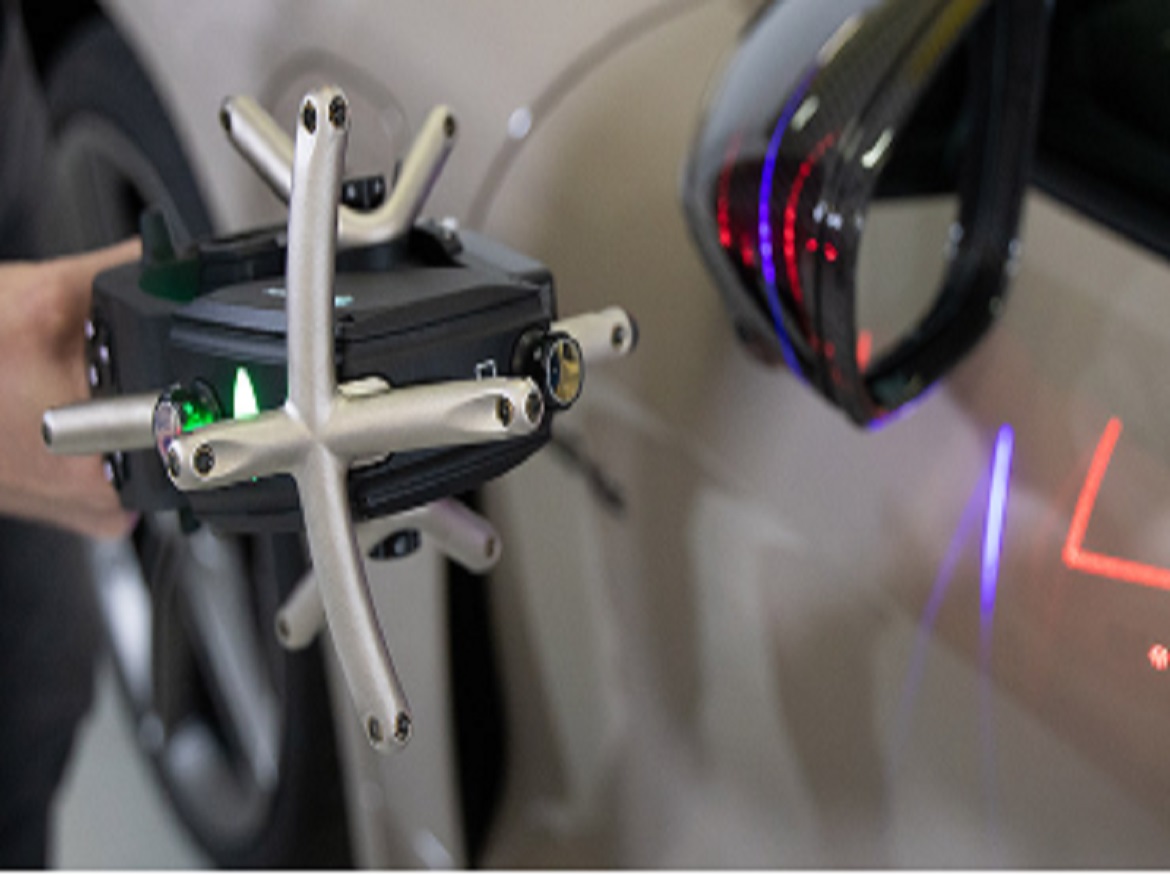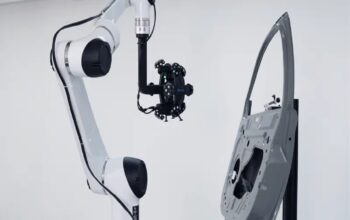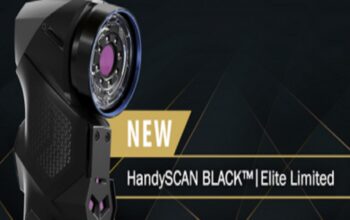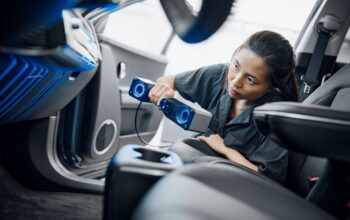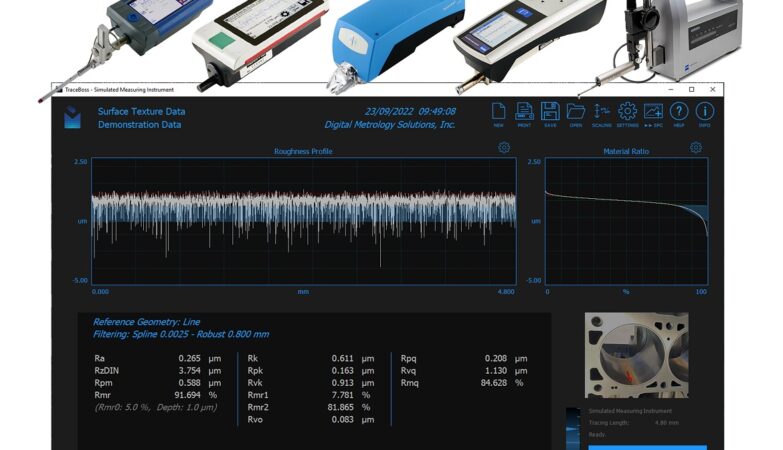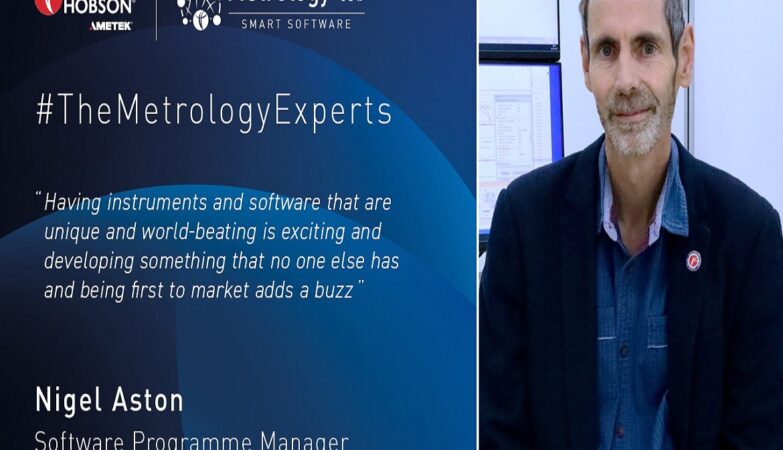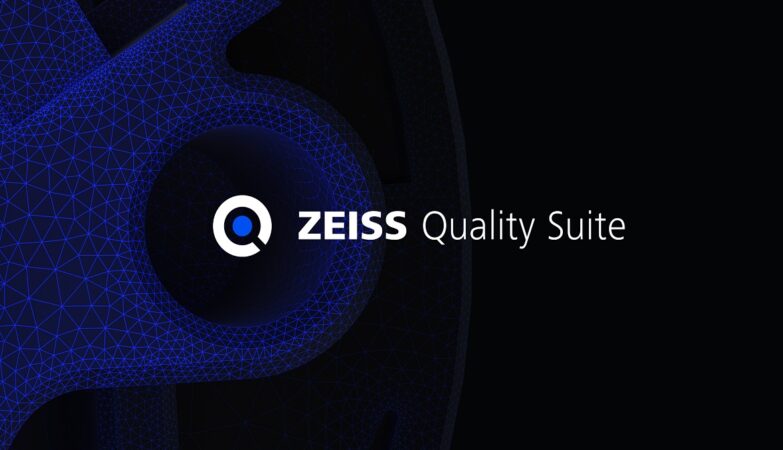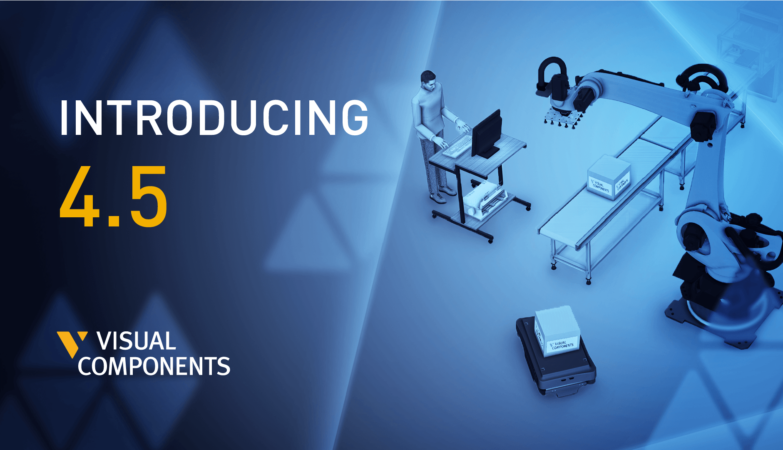Innovation in 3D scanning
In the past, part inspection was mainly all about tactile measurement. In the twenty-first century, technological improvements that have delivered greater accuracy and easier usage have however seen laser scanning become an increasingly important and viable alternative for many inspection tasks. Laser scanners can acquire more than a million points in a second, covering an entire object instead of just a few key features. The result: an easy-to-understand colour map, comparing the acquired point cloud against the CAD.
The first generation of laser line scanners required that the scanner have optical exposure settings defined and fixed manually by the user for the type or colour of material to be measured. For example, a car is beige, but it has some black areas. An early laser line scanner could either scan one or the other surface colour, but never both in one pass.
![]()
A second generation of scanners offered automatic exposure, meaning that for every scan line, the scanner would find the best settings automatically, according to the surface colour perceived by the scanner’s camera. However, in this case the entire scan line always needed to be on the same surface colour because every point on the scan line was measured at the same exposure setting. This was certainly an improvement, and with the right series of scanner orientations was a technology that could be helpful, but it was still not perfect.
In the next generation of scanning technology, Hexagon introduced the ‘flying-dot’ scanning concept to the market. Scanners based on flying-dot technology could adjust the exposure setting on every single point along the laser line and therefore scan any material in any orientation. But this technique came with a drawback; the motorisation needed within the scanner to make this type of scanning possible also made it relatively slow.
Today, the laser line scanner market for portable metrology systems has evolved even further. The introduction of functions such as dynamic exposure settings and automatic noise elimination have allowed great improvements in scanning usability and data quality. The Absolute Scanner AS1 from Hexagon uses a set of optical algorithms known as SHINE (Systematic High-Intelligence Noise Elimination) technology, which empowers scanning on challenging materials such as chrome, shiny black or multi-colour surfaces by filtering scan data outliers without compromising scanner performance and accuracy.
This article will describe the benefits of the SHINE technology carried by the Absolute Scanner AS1, as well as explaining some of the technical characteristics that provide them.
The increasing importance of dynamic exposure settings and automatic noise elimination
While scanning speed (in terms of points collected per second and per line) has consistently increased over the years since non-contact scanning measurement was first introduced, the complexity of measurement surfaces has also grown, as the application of scanning technology has broadened into new areas of manufacturing.
The need to scan different types of surfaces when inspecting manufactured parts is driven by the rapidly increasing demand from manufacturers to use different materials. For instance, the use of composites/carbon fibre, as well as different finishing materials, to stay competitive in the market while at the same time bring an improved value proposition to their products. And of course, other conventional surfaces such as plastics and aluminium remain in demand and are often used alongside new materials and finishes.ch as plastics and aluminium remain in de-mand and are often used alongside new materials and finishes.
Here are some examples of real-world applications in modern industrial manufacturing.
Composite component manufacturing
![]()
Carbon composite material is often used in manufacturing for automotive or aerospace, as well as in for instance sports equipment. This is because of its strength, low weight, resistance, and flexibility. A fast way to inspect a finished carbon surface is by using a laser line scanner. Because the material is dark with a knitted texture, an exposure change of the scanner would therefore be necessary to adapt to the surface. These materials are also expensive, and so scrap must be reduced to a minimum, meaning measurement needs to be accurate at all times.
Turbine maintenance
![]()
In the maintenance, repair and overhaul (MRO) area of gas or steam turbines, the reworking of the turbine blades is common as they are exposed to pressures such as propulsive forces. After the blade polishing process, a quick way to inspect the reworked blades is to create a 3D scan and compare with the master CAD.
Because of the shiny surface of the blade and the curvature of the leading and trailing edges, a correct exposure setting for the laser scanner is needed to avoid the risk of outliers on the edges.
Automotive interiors and exteriors manufacturing

Car interior panels, wing mirrors and bumpers typically have a dark glossy finish on trimlines around the surface or sometimes over the surface. One of the reasons for using this dark glossy material is to bring a more elegant look to the panels, going in hand-in-hand with the increased quality perception delivered by the way flush and gap requirements have tightened in automotive interiors over the past 10 years.
Having to inspect and scan these shiny surfaces requires a very high laser line intensity and correct camera exposure; too high laser intensity could lead to outliers around the scan data.
Fundamentally, all these examples show how often operators need to find the right exposure settings and laser intensity to use when scanning different surfaces.
Scan settings: the challenge of finding the right balance
With typical laser scanners, a measurement session would begin with the operator needing to choose appropriate settings for the part’s surface. Is the surface pale or dark? Is it shiny or matte? Is it rough or smooth? This complexity can cause different operators to interpret the scanner settings in different ways, causing variability in the scan data introducing room for errors.
The table in Figure 1 shows the relationship between the part’s surface darkness and the scanner’s optical settings. As a surface becomes darker, the exposure time of the scanner’s camera (here shown as ‘Exp time’) must be increased to be more sensitive to incoming light, because a dark surface returns less laser light to the scanner’s sensor. The operator should therefore move the cursor to the right to a higher percentage value in order to scan the part correctly. However, this increase also raises the risk of spurious data (or ‘noise’) appearing in the scan. A smooth part might appear rough in the scan or outliers might give the scan an incorrect shape. Equally, if the settings are too low, there might be areas of missing information in the scan.
It is often therefore difficult to find in the settings the correct compromise that will allow the part to be measured in the most effective and accurate way possible.

Figure 1: Scanner settings adjustment options
What is SHINE?
SHINE stands for Systematic High Intelligence Noise Elimination.
SHINE is a patented type of High Dynamic Range (HDR) technology that allows measurement of surfaces of different colours and levels of glossiness in a single scan pass. By using 3 different exposure levels for each measured scan line, all surface information is captured using the optimum settings at all times; one low-level exposure captures light or matte surfaces, a second high level exposure captures high-gloss and dark surfaces, and a medium-level exposure is used for other surface types.
Because SHINE ensures that the scanner is always operating in its optimum configuration, the range of surfaces that can be scanned is wider than with conventional scanners. And this automatic adjustment to a more optimum exposure level also allows for much cleaner data collection, as the noise created by scanning a surface at an unoptimised exposure setting is eliminated.
What SHINE means for the user is that the scanner can be simply picked up and used with very little training. Knowledge of the scanner settings described earlier in this document is not necessary, so parts can be scanned accurately without the variability caused by different interpretations of the settings. Operator ‘A’ will obtain the same results as Operator ‘B.’
Another benefit of having fully automatic settings is improved reproducibility. When scanners had their exposure settings manually set, results between different users who used different settings were an issue. By using SHINE, different users will get the same result, making for a much more consistent metrology tool.
SHINE also saves time, as there is no need for running trials on the part before starting the measurement job. The SHINE algorithm could be compared to the best automatic camera settings ever developed. Imagine a camera that can take photos in automatic mode better than a professional photographer – that is what SHINE offers.
The Absolute Scanner AS1 and its positioners (Absolute Tracker and Absolute Arm)
A laser scanner works by capturing 2D scan lines from the part surface. To provide a final 3D point-cloud to the user, this 2D information from the scanner must be combined with positional data that locates it in 3D space. This positional data comes from a ‘positioner’, which generally carries the scanner around the part. Examples of positioners include articulated arms, laser trackers and CMMs. The Absolute Scanner AS1 was the first scanner on the market that is compatible with multiple positioners, so that it can be swapped between laser tracker and portable measuring arm systems on the fly.
![]()
Laser trackers are portable systems able to accurately measure 3D points over large distances in any environment. Hexagon’s range of laser trackers are known as Absolute Tracker systems, named for the Absolute Encoders that ensure their high performance. They can be used to inspect parts from a size of just a few centimetres up to a those with a measurement volume of 160 metres in diameter. A laser tracker’s strength is on medium-to-large-sized objects like car bodies, railway bogies or coaches, aerospace frames and energy turbines.
Our Absolute Tracker systems can be enhanced by probes and scanners, which can be either handheld or mounted on robots for automated operation.
For objects that are up to 4.5 metres long, a portable measuring arm is a strong alternative measurement solution. Hexagon’s range of portable measuring arms are known as Absolute Arm systems, also named for those vital Absolute Encoders. They are portable coordinate measurement machines that can be easily carried to a measurement object and they offer both tactile and contactless measurement options. For decades, the portable measuring arm has been in use in almost every manufacturing industry, due to its reliability, versatility and portability.

The AS1 is compatible with all AT960 Absolute Tracker models, as well as with RA8 7-Axis Absolute Arm models. The modular design and RDS software integration allow the user to swap the AS1 between the Absolute Arm and the Absolute Tracker AT960 and use it right away with no additional scanner alignment.
The AS1 can even be used straight out of the box, as no warmup time is required when powering on. That’s important not only for multi-instrument use cases, but also for automated cells with a tool changer.
The cross-platform compatibility of the AS1 allows customers to minimise their investment, by sharing a single scanner between two instruments. On top of that, inspection of large structures is not always possible with a laser tracker due to line-of-sight issues. The combination with
the portable measuring arm makes any measurement task possible.
The HP-L-10.10 Laser Scanning Sensor
With the success of SHINE technology on portable measuring devices, Hexagon have moved to build the same technology into their CMM product range with the introduction of the HP-L-10.10 Laser Scanning Sensor.

Manufacturers employing ultra-high-accuracy CMMs have previously become accustomed to trading speed for that high level of accuracy when implementing 3D scanning solutions. Thanks to SHINE, the HP-L-10.10 allows CMM scanning to offer similar repeatability and performance to tactile measurements carried out on the same measurement machine. The scanner is both 7 times faster than its predecessor while simultaneously delivering accuracy (probing form error) to within as little as 8 microns.
Achieving this level of speed and precision along with excellent data quality and the ability to inspect a wide variety of surfaces and finishes within the same measurement sessions would simply be impossible without the advanced algorithms built into the SHINE platform.
Conclusion
SHINE is a powerful set of algorithms that have transformed the usability of laser scanning. Embedding this technology in the Absolute Scanner AS1 has delivered a scanner that can deliver accurate and fast results with minimal user intervention like no other on the market. With the AS1 the level of expertise of the user doesn’t matter; SHINE takes over and ensures the proper settings for the easy acquisition of clean and reliable data.


